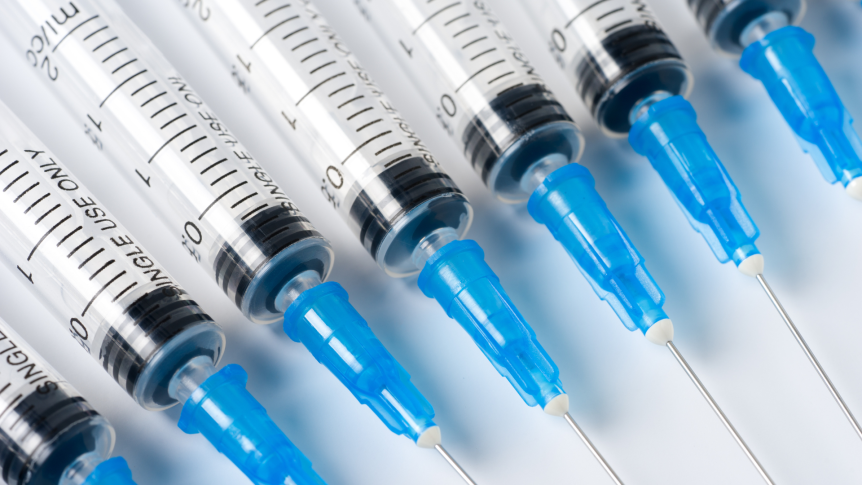Provided By: GoodRX
Throwing away syringes, needles, and lancets — commonly called “sharps” — is important to prevent injury. Properly disposing of them can also help you avoid infections from used needles, including hepatitis B (HBV), hepatitis C (HCV), and HIV.
Here, we’ll cover some basic facts about how to get rid of sharps — including syringe needle disposal, the best sharps container, and how to get sharps containers.
What are sharps?
The term “sharps” describes medical devices and supplies that have sharp points or edges. These items can poke through the skin. Sharps are used to manage multiple medical conditions, including cancer, diabetes, and infertility.
Examples of products that are considered sharps include:
- Needles
- Syringes (devices that attach to needles to inject medication)
- Lancets (devices that can be used to get blood drops for lab tests)
- Autoinjectors (prefilled syringes that contain medications)
Examples of medication products that are considered sharps include:
- Vitamin B-12 (cyanocobalamin) injections
- Testosterone (testosterone cypionate) injections
- Insulin injections like Humalog (insulin lispro) and Lantus (insulin glargine)
- Blood thinner injections like Lovenox (enoxaparin)
- Emergency injections like EpiPen (epinephrine)
- Migraine injections like Imitrex (sumatriptan)
How do I dispose of used needles and other sharps?
After using a needle or other sharp item, it’s best to get rid of it right away. This helps you avoid an accidental needle stick or cut.
The best place to dispose of needles and other sharps is in a sharps disposal container (more commonly known as a “sharps container”). These are sturdy, plastic containers that are resistant to leaks and punctures from sharps. They also come with a lid.
An FDA-cleared container is the best kind of sharps container. But if you can’t find one, a sturdy plastic container will work, too.
How do I dispose of unused needles and other sharps?
Unused or unopened sharps may be dangerous if someone opens them. To get rid of unused sharps and unopened sharps, you can consider donating them. Some organizations accept unused medical supplies and donate them to those in need. But if you can’t donate them, you should still dispose of them in a sharps container as if they’re used.
How to get a sharps container
You can purchase an FDA-cleared sharps container without a prescription. You can also ask your healthcare provider to write a prescription for you. Some insurance providers may cover sharps containers with a prescription.
Sharps containers can be found in pharmacies, medical supply companies, or through your healthcare provider. They can also be found online. If you don’t want to buy a sharps container, check for free options. Contact the manufacturer of your medication or your local health department.
The best sharps container is the one that fits your needs and lifestyle. Keep this in mind when choosing yours. For example, a larger sharps container may work great in a place where it doesn’t need to move, like at home. Small-sized sharps containers are available for people who are on the go or traveling.
Are there any alternatives to an FDA-cleared sharps container?
If you don’t have immediate access to an FDA-cleared container, you can use a household container like an empty laundry detergent bottle or an empty bleach container.
If you use an empty household container, make sure it meets the FDA’s recommendations:
- Made of sturdy plastic that can’t be punctured with a needle or other sharp object
- Leak-resistant
- Has a lid that fits tightly
- Able to stand upright on its own
- Properly labeled to warn of hazardous waste
What should I do if I don’t have immediate access to a sharps container?
If you don’t have access to a sharps container or an empty household container, there are other ways to store sharps in the meantime. One option is to recap the needle. You’ll want to do this using one hand. This protects you from an accidental needle stick.
To recap the needle, place the cap on a flat surface. Using one hand, hold the syringe with the needle attached and line up the tip of the needle with the opening of the syringe cap. Insert the needle into the cap without using your other hand. Once the needle is capped, press the needle against a hard, flat surface to secure the cap firmly.
You can also make syringes unusable by removing the needle using a needle clipper. This special tool separates the needle from the rest of the syringe. If you use a needle clipper, the needle will stay within the clipper once it’s cut. Needle clippers can’t be used on lancets.
Even if you recap your needle or use a needle clipper, needles and syringes need to be thrown away in a sharps container as soon as possible. Never throw medical sharps away like ordinary trash and don’t flush them down the toilet.
What should I do with a full sharps container?
Sharps containers should be replaced when they are about three-fourths full. Here are a few recommended ways to dispose of needles:
- Find a drop-off location. Some hospitals, health clinics, and pharmacies may act as collection sites. They may have a sharps disposal drop-off box, but be sure to check with them first.
- Check locations that accept household hazardous waste. Some places that accept household hazardous waste, like paint, motor oil, and batteries, may also accept sharps containers. Check with your local health department to find out if any of these exist in your area.
- Use a pick-up or mail-back service. Some services may come to your house to pick up your sharps containers. Other services allow you to mail the sharps container to them. These services are convenient but you usually have to pay for them.
